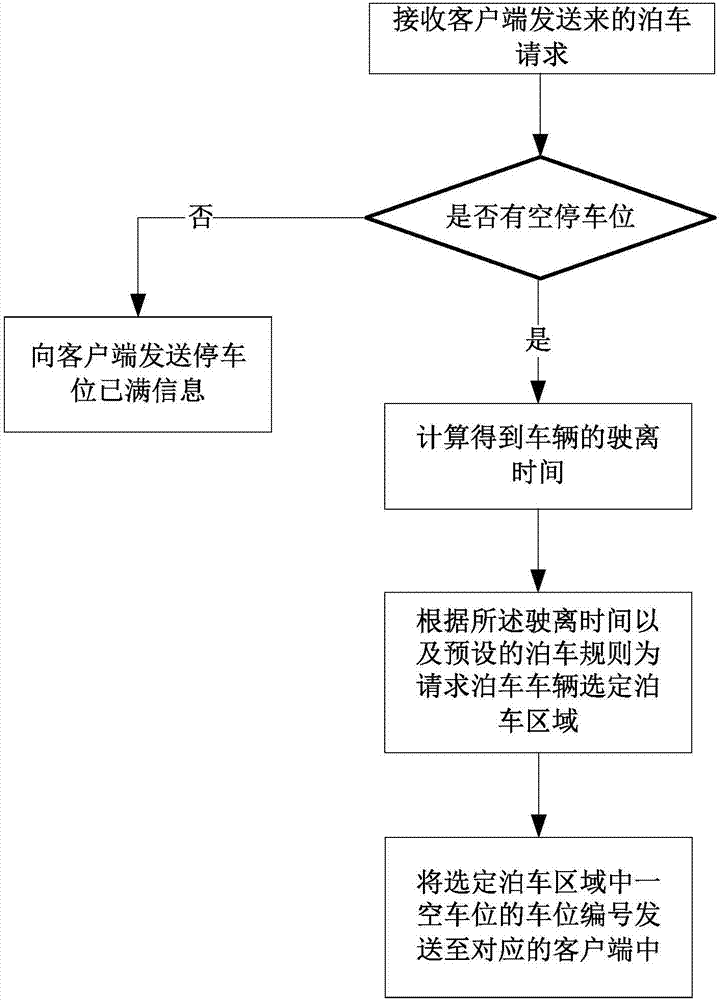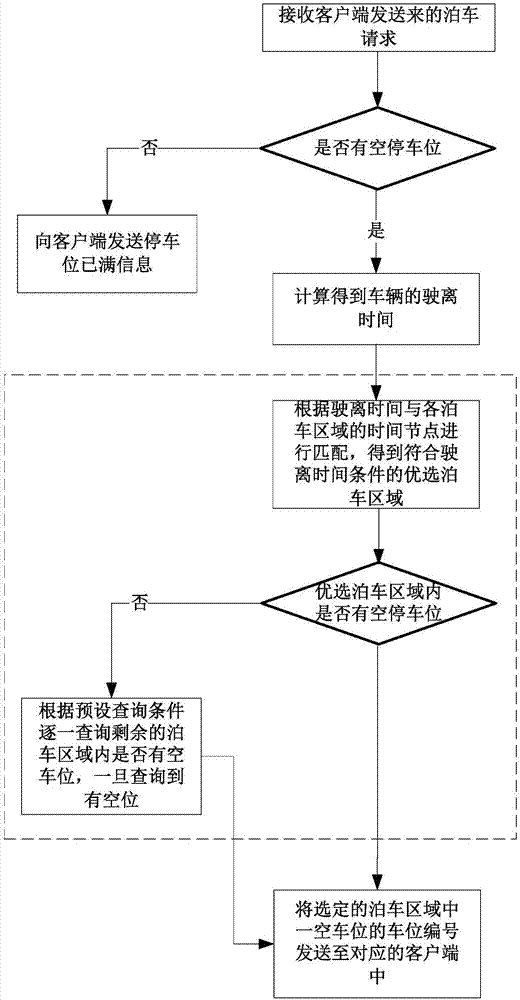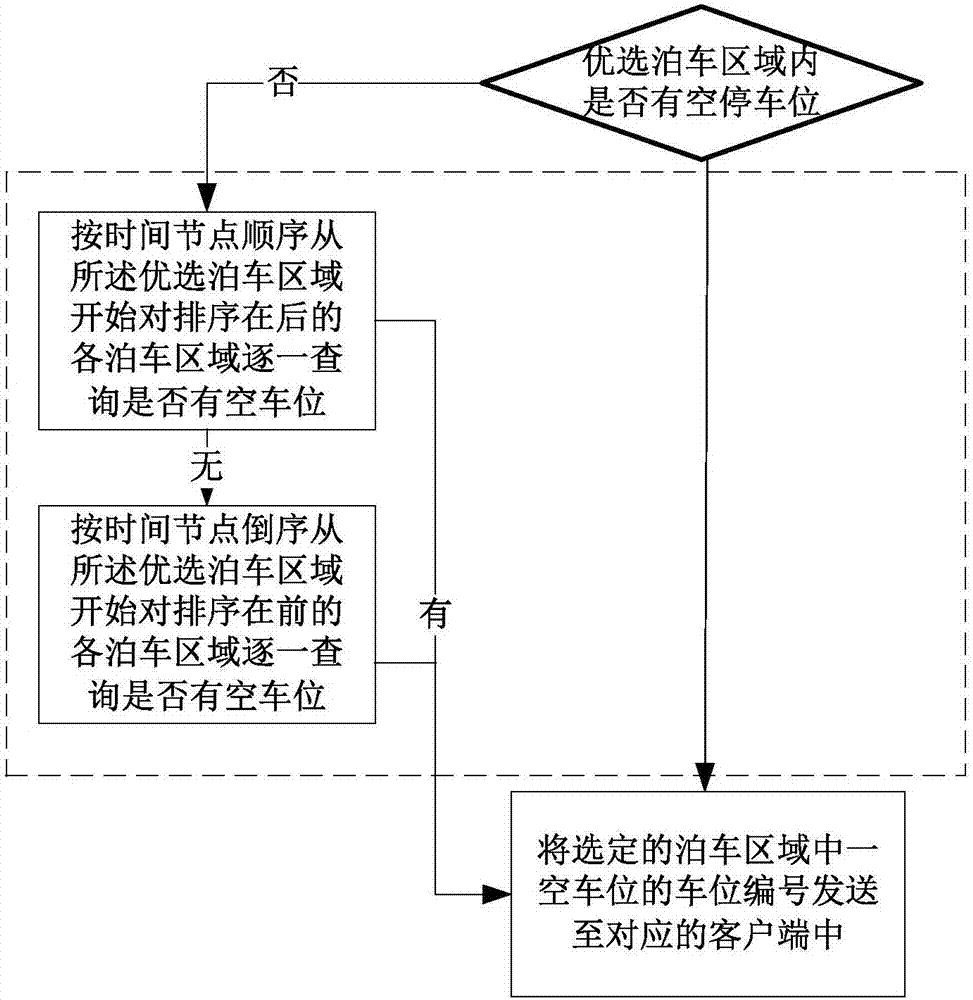Parking lot management method and system
A technology of parking space management and parking space, which is applied in the field of parking space management, can solve problems such as low work efficiency, running back and forth of vehicle managers, troublesome vehicle managers, etc., to achieve the effect of saving energy, avoiding running back and forth, and improving work efficiency
- Summary
- Abstract
- Description
- Claims
- Application Information
AI Technical Summary
Problems solved by technology
Method used
Image
Examples
example 1
[0066] Example 1 is one of the allocation methods, such as image 3 As shown, the step D3 specifically includes:
[0067] Step D3101: Starting from the preferred parking area in the order of time nodes, check whether there are vacant parking spaces in each of the subsequent parking areas one by one. Once the vacant parking space is found, perform step E, and if there is no vacant parking space, perform step E D3102;
[0068] It should be understood that vacant parking spaces may exist in the parking area after the preferred parking area, and whether there are vacant parking spaces in each parking area is inquired backward one by one from the preferred parking area in the order of time nodes, for example, assuming that there are a total of There are 6 areas in the car area A-F, and the preferred parking area is matched to the parking area C, and there is no vacant parking space in the parking area C, then the parking areas after the parking area C are D, E, F, then, Start pol...
example 2
[0072] Example 2 is another allocation method, such as Figure 4 As shown, the step D3 specifically includes:
[0073] The step D3 also specifically includes:
[0074] Step D3201: Starting from the preferred parking area, check whether there is any free parking space in the next parking area. Once there is a free space, execute step E. If there is no empty space, execute step D3202;
[0075] Step D3202: Starting from the preferred parking area, check whether there is any free parking space in the previous parking area. Once the space is found, execute step E, and if there is no empty space, execute step D3203;
[0076] Step D3203: In the order of time nodes, start from the first parking area in the preferred parking area and inquire backward one by one whether there are vacant parking spaces in each parking area. Execute step D3204;
[0077] Step D3204: Query whether there are vacant parking spaces in each parking area one by one starting from the first parking area in the ...
example 3
[0080] Example 3 is another allocation method, such as Figure 5 As shown, the step D3 specifically includes:
[0081] The step D3 also specifically includes:
[0082] Step D3301: Starting from the preferred parking area in reverse order of the time node, check whether there are vacant parking spaces in the previous parking areas one by one. Once the vacant space is found, perform step E, and if there is no vacant space, perform step D3302;
[0083] Step D3302: Start from the preferred parking area in the order of time nodes to check whether there are vacant parking spaces in each subsequent parking area one by one, and execute step E once the vacancy is found.
[0084] The above example 3 is similar to Example 1. It starts from the preferred parking area to query the previous parking area. For example, the preferred parking area is C, and the preferred parking area is forwarded one by one according to the reverse order of time nodes. Query whether there are vacant parking s...
PUM
 Login to View More
Login to View More Abstract
Description
Claims
Application Information
 Login to View More
Login to View More - R&D Engineer
- R&D Manager
- IP Professional
- Industry Leading Data Capabilities
- Powerful AI technology
- Patent DNA Extraction
Browse by: Latest US Patents, China's latest patents, Technical Efficacy Thesaurus, Application Domain, Technology Topic, Popular Technical Reports.
© 2024 PatSnap. All rights reserved.Legal|Privacy policy|Modern Slavery Act Transparency Statement|Sitemap|About US| Contact US: help@patsnap.com










